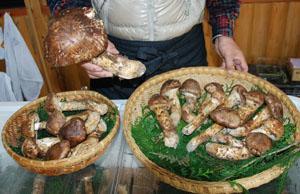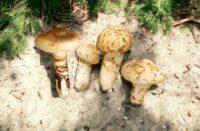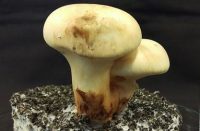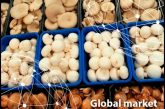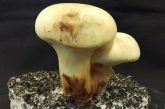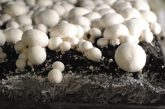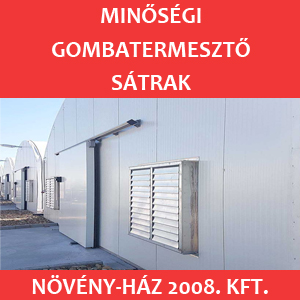When it comes to status — and exorbitant prices — “matsutake” mushrooms may be in the same league as caviar and truffles.
But this year’s matsutake were a lot cheaper because of a plentiful harvest that owes its thanks to an optimal amount of rain in September. However, “cheaper” is a relative term, as the delicacy still fetched prices of around ¥20,000 a kilogram this fall.
What is so special about matsutake to Japanese? Here are some questions and answers:
What are matsutake?
They are a kind of mushroom that grow on roots of red pines and other trees in and outside Japan. They have a strong smell, which the Japanese at least think stimulates the appetite. They typically measure 10 to 20 cm in length.
In Japan, the picking season runs between September and October. They are harvested when the cap is not yet completely open, because the aroma fades away if it is open.
How far back does Japan’s love affair with matsutake go?
Japanese have enjoyed eating them since ancient times. Clay statues shaped like various mushrooms, including one apparently depicting matsutake, were found in ruins from the Jomon Period (from 13,500 years ago to about 3,000 years ago), according to the website of the Japan Special Forest Production Promotion Association.
The statues are thought to be mushroom samples to distinguish the edible variety from those that are toxic, the website says.
Matsutake were often a subject of tanka in the Nara and Heian periods, from 710 to 1192. Samurai enjoyed picking matsutake, the website says, citing a historical document.
How much do they cost?
Prices range a great deal between domestic and imports. The cost of mushrooms picked in Japan fluctuate widely every year because the harvests are unstable. Matsutake from the Kamiina region in Nagano Prefecture cost about ¥20,000 per kilogram after a good harvest, but the prices can reach about ¥100,000 in a bad year, says Minoru Moriya, an official at Japan Agriculture Kamiina, Nagano. Nagano is Japan’s top matsutake-producing prefecture.
Matsutake imported from the United States, China and other countries were priced at ¥3,000 to ¥9,000 per kilogram in wholesale markets in Tokyo during the 12 months to September, according to the Tokyo Metropolitan Government’s website.
It says matsutake from South Korea cost ¥33,407 on average during the same period. The South Korean mushrooms are more expensive than other imports because the shorter shipping time means they are more fresh, says Akiyoshi Yamada, who researches matsutake at Shinshu University in Nagano. The matsutake market is worth ¥30 billion to ¥40 billion a year, Yamada says.
Why are matsutake so expensive, and why do the imports cost less than the domestic mushrooms?
Matsutake are expensive in general due to their scarcity. Unlike shiitake, “shimeji” and other mushrooms, growing them artificially is incredibly difficult despite farmers’ relentless efforts.
Also, habitats suitable for matsutake are shrinking. They grow on soil free of fallen leaves, but such areas are disappearing along with the Japanese tradition of picking up leaves for fertilizer and fuel as more modern alternatives are adopted.
Domestic matsutake are more expensive because Japanese prefer them to imports, which lose their aroma during transport, Moriya says. Strong Japanese loyalty to the “domestic matsutake brand” also keeps the prices high, he says.
Where are matsutake harvested?
When it comes to quantity, Japan is actually not a major producer. Consumption of domestic matsutake came to 24 tons in 2009, 1.5 percent of Japan’s total consumption of 1,621 tons, according to the agriculture ministry.
Matsutake coming from China accounted for 73 percent of the total, followed by Canada at 10.2 percent and the United States at 9.8 percent. In Japan, Nagano, Iwate and Yamaguchi prefectures are regular top producers.
Why aren’t they as popular in other countries?
There are several reasons, says Moriya of Japan Agriculture Kamiina. For one thing, people in other lands never had a habit of eating them; not many people — besides Japanese — find the smell to their liking; and harvesters outside Japan don’t find the business of growing and selling matsutake profitable because of the widely fluctuating prices.
Do people in other countries eat matsutake?
Yamada of Shinshu University says apart from Japan, South Korea is just about the only place where people eat a lot of matsutake. However, the harvest in South Korea mainly ends up in Japan rather than on domestic tables, he says.
Wasn’t North Korea a major exporter of matsutake to Japan?
Yes, until 2006, when North Korea shipped 230 tons worth ¥827 million to Japan, making it the second-largest matsutake supplier after China. Japan has not imported matsutake from North Korea since 2007 as part of economic sanctions over the North’s nuclear programs and its reluctance to resolve the abduction issue.
In 2002, when Prime Minister Junichiro Koizumi visited North Korea for a breakthrough summit, Kim Jong Il reportedly gave him matsutake as souvenir, but this was denied by Koizumi’s administration.
How are they eaten?
Popular matsutake dishes include “dobin mushi” (matsutake steamed in a clay teapot) and “matsutake gohan” (rice mixed with matsutake).
Typically, the mushrooms are cooked with only a light seasoning so their smell isn’t hidden. It is recommended that they are eaten soon after harvesting because they tend to lose their aroma quickly.
Why did we have an ample harvest this fall?
Because Japan got the optimal amount of rain in September, which has a huge influence on the matsutake harvest. The combination of a hot summer and wet September results in a terrific matsutake season, Moriya says.
Source: The Japan Times


